Manchester Victoria station
Manchester Victoria station in Manchester, England is a combined mainline railway station and Metrolink tram stop. Situated to the north of the city centre on Hunts Bank, close to Manchester Cathedral, it adjoins Manchester Arena which was constructed on part of the former station site in the 1990s. Opened in 1844 and part of the Manchester station group, Victoria is Manchester's third busiest railway station after Piccadilly and Oxford Road and the second busiest station managed by Northern after Oxford Road.
 Station frontage of Manchester Victoria, constructed in 1909 | |
| Location | Manchester city centre, City of Manchester England |
| Coordinates | 53.4872°N 2.2424°W |
| Grid reference | SJ839989 |
| Managed by | Northern |
| Transit authority | Greater Manchester |
| Platforms | 6 |
| Other information | |
| Station code | MCV |
| Fare zone | City (D) |
| Classification | DfT category B |
| Key dates | |
| 1844 | Opened |
| 1902 | Extended |
| 1993–96 | Northern portion reconstructed |
| 2014–15 | Renovated |
| Passengers | |
| 2015/16 | |
| 2016/17 | |
| 2017/18 | |
| 2018/19 | |
| 2019/20 | |
Listed Building – Grade II | |
| Feature | Victoria Station including concourse to rear with restaurant and booking hall |
| Designated | 20 June 1988 |
| Reference no. | 1254725[1] |
| Notes | |
Passenger statistics from the Office of Rail and Road | |
The station hosts local and regional services to destinations in Northern England, such as Blackburn, Rochdale, Bradford, Leeds, Newcastle, Huddersfield, Halifax, Wigan, Southport, Blackpool (Sundays only) and Liverpool using the original Liverpool to Manchester line. Most trains calling at Victoria are operated by Northern. TransPennine Express services call at the station from Liverpool to Newcastle/Scarborough and services towards Manchester Airport (via the Ordsall Chord) from Middlesbrough/Redcar/Newcastle.
Manchester Victoria is a major interchange for the Metrolink light rail system. Two former railway lines into the station have been converted to tram operation: the line to Bury was converted in the early 1990s, in the first phase of Metrolink construction, and the line through Oldham to Rochdale was converted during 2009–2014. In the other direction, trams switch to on-street running when they emerge from Victoria Station and continue southwards through the city centre to Piccadilly or Deansgate-Castlefield.
In 2009, Victoria was voted the worst category B interchange station in the United Kingdom.[2] The station underwent a two-year £44 million modernisation programme which was completed in August 2015.[3][4] Renovation entailed electrification of lines through the station, renewed Metrolink stop with an additional platform, restoration of listed features, upgraded retail units, and a new roof.[5][6] The Ordsall Chord directly linking Victoria to Oxford Road and Piccadilly was completed in December 2017. In the Northern Hub proposals, Victoria will become the rail hub for TransPennine Express and Northern Connect services by the end of 2020 with passenger numbers expected to rise to 12 million as a result.[7]
History


Origins
The Manchester and Leeds Railway (M&LR) was founded in 1836 and the company began building its line between Manchester and Leeds in 1837. Originally its line terminated at Manchester Oldham Road, which opened on 3 July 1839. The company realised it would be advantageous to join its line to the Liverpool and Manchester Railway (L&MR), creating a through route from Liverpool to Yorkshire with a joint station serving the centre of Manchester.[8] In 1839, Samuel Brooks, vice-chairman of the M&LR, bought land at Hunt's Bank close to the cathedral and presented it to the company for the new station. The site was on the north bank of the River Irk, between the workhouse to the north which had opened in 1793 and Walker's Croft Cemetery to the south. After several years of negotiations between the companies, work started in 1842. The M&LR built an extension from Miles Platting to the station which opened on 1 January 1844. On this date, the Oldham Road terminus was closed to passenger services and became a goods station. The new station had a 852 ft (260 m) long single platform which handled M&LR trains to Leeds and elsewhere at its eastern end. The L&MR extended its line from Ordsall to Victoria and its trains operated from the western end from 4 May 1844, on which date its Liverpool Road station terminus became a goods station.[9][10]
The station was named Victoria in 1843. Its long, single-storey building, designed by George Stephenson and completed by John Brogden, was approached by a wooden footbridge over the River Irk before the river was culverted.[11][12] Most of the original 1844 station buildings are standing including part of the original façade on Hunt's Bank.[13]
The L&MR became part of the Grand Junction Railway in 1845, which in turn amalgamated with other railways to create the London and North Western Railway (LNWR) in 1846; the M&LR amalgamated with other railways to create the Lancashire and Yorkshire Railway (L&YR) the following year. The headquarters of the L&YR were based alongside Victoria.[14]
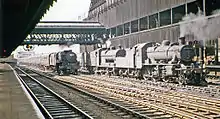
Expansion
By the mid-1840s six railway companies operated from the station connecting Manchester to London, Glasgow, Liverpool, Leeds and Sheffield. Victoria Station dominated the Long Millgate area and was one of the biggest passenger stations in Britain.
Victoria underwent several phases of expansion as traffic grew. In 1865, four bay platforms were built on the eastern side on land reclaimed from the cemetery, and another was built on the western side, a second through platform was built at the northern side, and the station's facilities were expanded by the construction of a new east wing of the station building.[15] Two decades later, the L&YR purchased the workhouse north of the station and its site was used to build another bay and five through platforms which came into use in 1884.[16] That same year, the LNWR opened its own station, Manchester Exchange immediately to the west on the opposite side of the River Irwell, and vacated Victoria.[17]
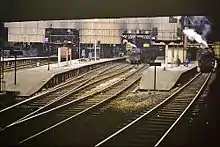
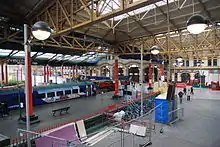
Victoria reached its maximum extent of 17 platforms in 1904 when the station was enlarged with extra bay platforms to the south. The present station façade, designed by William Dawes, was built in 1909.[18] The cast-iron train sheds behind the façade were 700 yards (640 m) long.
Because the station handled large amounts of parcel and newspaper traffic, an overhead parcels carrier system was constructed in 1895. It consisted of an electrically powered trolley suspended from an overhead track operated by an airborne attendant. A large basket could be raised and lowered from the trolley to distribute parcels and newspapers across the station. The system operated until 1940.[19][20]
The L&YR merged with the LNWR on 1 January 1922. A year later, the merged company became the largest constituent of the London, Midland and Scottish Railway (LMS). From 16 April 1929, Victoria and Exchange station were linked by the westward extension of platform 11 over the Irwell bridge, known as platform "11 Middle", which joined to Exchange's platform 3 to create Europe's longest platform at 2,238 feet (682 m). Crossovers enabled it to accommodate three trains arriving and departing independently.[21][22] Exchange Station closed in 1969 and its services were transferred to Victoria.[23] The Exchange Station site opposite the cathedral was for many years used as a car park, until redevelopment of the site began in 2015.[24]
The station suffered bomb damage during the Manchester Blitz in World War II. On 23 December 1940, several bombs hit the station destroying the parcels office, and a large part of the roof over platforms 12 to 16. The parcels office was rebuilt, but the damaged parts of the roof were taken down and not replaced.[25] The station came into the ownership of British Railways in 1948.
Picc-Vic tunnel and Metrolink
Proposals to build an underground station, Victoria Low Level as part of the Picc-Vic tunnel project emerged in the early-1970s.[26] The scheme proposed creating a direct rail link between Victoria and Manchester Piccadilly via a tunnel and creating several underground stations in Manchester city centre. Platforms 1–4 at Victoria were taken out of use in 1973 in anticipation of the tunnel coming to the surface in that part of the station.[27]
The tunnel project was cancelled in the late 1970s because of high costs, and in the 1980s transport planners turned to light rail as a lower-cost option. As a result, the stations were linked by the Manchester Metrolink system which opened in 1992. A street-level tramway was built across the city centre linking the stations and two converted rail lines to Altrincham and Bury.[28] The tram stop at Victoria replaced the former Bury Line platforms and the tram line was extended into the streets through a new entrance in the side of the station.[29]
Downsizing

In the 1980s and 90s, British Rail adopted a policy of concentrating Manchester services into Manchester Piccadilly. In 1989, the Windsor Link chord in Salford opened, enabling many of Victoria's services from the north to be diverted to Piccadilly and in the same year, trans-Pennine services were also transferred.[30][31] Victoria was reduced to six platforms, and part was sold for development. Between 1992 and 1994, the Manchester Arena was built over the northern part of the station site. Three of the five through tracks between platforms 11 and 12 were removed, along with platforms 12-17. The station was reduced to four through tracks and four through platforms, three of which were built to replace the removed platforms 12-14. They are covered by the Arena which was joined to the station by means of a raft above them. The Arena is accessed via stairs on Hunts Bank and from the station concourse. Following reconstruction, the platforms were renumbered; platforms 1 and 2 are bay platforms facing east (formerly platforms 9 and 10), and the through platforms are 3 to 6 (platform 3 was formerly platform 11). The through platforms are used by mid-distance services.[23][32]
Renovation
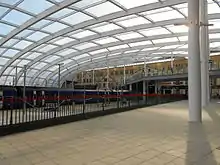

In 2009, Victoria was identified as the worst category B interchange station because of its dilapidated fabric and environment. The Transport Secretary, Lord Adonis, announced that, with nine others, it would receive a share of £50 million for a refurbishment programme.[33] Victoria's £5m share of the 'Better Stations' Network Rail funding for improvements was cancelled in the June 2010 budget cuts,[34] but replacement funding was arranged.[35] On 16 February 2010, Network Rail announced its intention to refurbish the station as part of the Northern Hub improvement proposals turning it into an interchange for local and regional services throughout north-west England. In August 2010, Network Rail announced the work would go ahead, despite the withdrawal of the £5 million funding.[36] Station improvements included an ETFE roof, restoration of its walls, exterior canopy and period features, new platforms for additional services, improved access to the Manchester Arena and improved retail and dining facilities.[37]
Work to refurbish the station began in April 2013.[38] The old roof was dismantled in autumn 2013.[39] Installation of the £17 million roof began in May 2014 and final roof beam was lifted into position on 13 October 2014. Installation of the ETFE sheeting was completed in spring 2015, and the station upgrade was completed in August 2015,[4] with the official reopening that October.[40]
The Ordsall Chord was finished in 2017 and links Victoria to Piccadilly.[41] It is anticipated that, after re-routing services, passenger numbers would increase to 12 million by 2019, compared with 6.6 million in 2011/12.[42] The chord allows trains to run directly between Piccadilly and Victoria, shortening journey times on TransPennine Express routes between Manchester Airport and Newcastle, Middlesbrough, Hull and Scarborough. An express service from Liverpool Lime Street to Newcastle via Victoria is operated by TransPennine Express. Reinstatement of the south and west curve at Todmorden on the Caldervale Line facilitated a direct service between Victoria and Burnley Manchester Road Station for the first time in almost fifty years.
Electrification
In the 1900s the Bury Line, a busy commuter line which served the suburbs of north Manchester from Victoria, was losing passengers to tramway competition, in response to this, in 1914 the L&YR decided to electrify this line using a unique 1,200 volt side-contact third rail system, in an effort to win back passengers. Electrification of this route was completed in 1916. As the scheme was a success, in the early 1920s the L&YR drew up plans to extend electrification to the Oldham Loop Line using the same system. The scheme progressed to an advanced stage, however with the reorganisations of railway companies in the 1920s, the new management had no interest in pursuing the scheme and it was dropped. This meant that the Bury Line remained as the only electrified line into Victoria, and it remained as such until 1991 when it was closed to be converted into part of the Metrolink system.[43]
No further electrification came to Victoria until the 21st century, when as part of Network Rail's Northern Hub scheme, overhead electric wires have been erected to Victoria from Manchester to Liverpool in 2015,[44] and Manchester to Preston and through to Blackpool in 2019.[45]
Layout
Manchester Victoria has six railway platforms and the Metrolink stop has four (four platform faces on three tracks). Two railway platforms are bays numbered 1 & 2 for terminating trains arriving from the east and four are through platforms numbered 3-6 at the northern side of the station. The Metrolink platforms are parallel to, and south of, the bay platforms. Only the bay and Metrolink platforms are under the new roof, the through platforms 4, 5 and 6 are mostly covered by Manchester Arena.
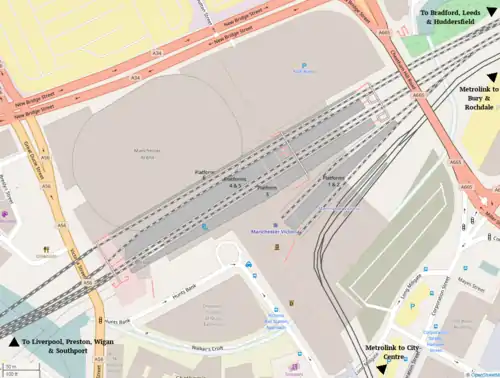
Architecture and features
The original M&LR single-storey offices facing Hunt's Bank Approach were built in the Italianate style in sandstone ashlar with slate roofs in 1844. They were later enlarged and given a second storey. William Dawes built the station's larger extension for the L&YR in 1909. It is at right-angles to the north end of the old station giving the enlarged station an L-shaped plan. Facing Victoria Station Approach, its façade is in the Edwardian neo-Baroque style, four storeys high and 31 bays to the rounded corner at the south-east end. The ground floor windows have rounded heads and those on the floors above are square. The ornate glass and iron canopy along the façade displays the names of destinations that the station served in Art Nouveau lettering.[1] The canopy was damaged by the Provisional IRA's 1996 bomb placed in a street adjacent to the Arndale Centre and was restored four years later.[46]
Heritage features in the concourse were restored during the 2013-15 renovation, they include the café with its glass dome and mosaic lettering which was originally the first-class dining room, the adjacent bookstall, and the original 1909 wood-panelled booking hall. In the entrance is a large, white glazed tiled map showing the former network of the Lancashire and Yorkshire Railway.[1][47]
Underneath the map is a bronze World War I war memorial with effigies of Saint George and Saint Michael at each end which was installed in 1923.[47][48] At the south end of the concourse is the 'soldier's gate' which opened to the former fish docks from where thousands of soldiers departed for World War I and where a bronze plaque was erected to commemorate them. The gateway was restored in 2015 and a steel screen inserted featuring a map of World War I Commonwealth grave cemeteries in Northern France and Belgium.[49]
The station received Grade II listed building status in 1988.[1]
 Station façade, and canopy with names of destinations
Station façade, and canopy with names of destinations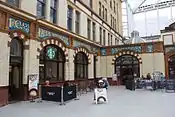 Restored former first class café and restaurant in the concourse
Restored former first class café and restaurant in the concourse The restored interior of the café.
The restored interior of the café.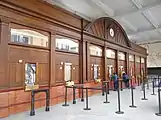 Booking office
Booking office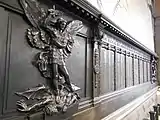 Bronze war memorial.
Bronze war memorial. Soldiers' Gate.
Soldiers' Gate.
National Rail services

.jpg.webp)

Manchester Victoria is served by two train operating companies, Northern and TransPennine Express. It is occasionally used by CrossCountry services during engineering works. The Chat Moss route to Liverpool is operated by TransPennine Express Class 185s DMUs and Northern Class 319 EMUs (peak time & early morning only). The Ribble Valley Line to Blackburn and Clitheroe is operated by Class 156, Class 150 with Class 153 strengthening services at peak times . Leeds Calder Valley services are usually operated by Class 158 Sprinter DMUs, though Class 195 Civity units are now used on many Chester trains. New stock is also being introduced on TPE routes in 2019-20, including Class 68 Nova 3 push-pull sets and Class 802 Nova 1 bi-mode multiple units.
Since the May 2018 timetable change, all express services on the North TransPennine route call at the station. These services are run by TransPennine Express. Westbound, two trains an hour run express to Liverpool Lime Street (one calling at Lea Green and the other calling at Newton-le-Willows). The other pair of services run westbound to Manchester Airport via the Ordsall Chord and Manchester Piccadilly. Eastbound, there are 4 trains per hour running via Huddersfield, Leeds and York. After York, one train an hour run to each of Edinburgh, Newcastle, Redcar Central and Scarborough.
Also since the May 2018 timetable change, services along the Calder Valley line have been significantly sped up. Stations between Rochdale and Manchester are now served by Blackburn services. This means that Calder Valley services now run non-stop between Rochdale and Manchester. As a result, there are now 6 trains an hour to Rochdale.
Westbound services
- 1 train per hour (tph) to Southport (via Bolton)
- 3tph to Wigan Wallgate via Atherton; one continues to Kirkby
- 1tph to Preston (not evenings; extended to Blackpool North on Sundays)
- 1tph to Chester via Warrington Bank Quay
- 2tph to Blackburn via Bolton, 1tph continues to Clitheroe
- 2tph to Liverpool Lime Street (express - limited stopping service also operates)
- 2tph to Manchester Airport
- 2tpd to Ellesmere Port (except Saturdays)
- 1tpd to Edinburgh Waverley (Sundays only)
Eastbound services
- 2tph to Rochdale calling at all stations.
- 3tph to Leeds via Rochdale, then 2 via Bradford Interchange & 1 via Brighouse
- 1tph to Blackburn via Rochdale & Todmorden
- 2tph to Stalybridge (stopping)
- 1tph to Scarborough via Leeds
- 1tph to Newcastle via Leeds
- 1tph to Edinburgh via Leeds and Newcastle
- 1tph to Redcar Central via Leeds
| Preceding station | Following station | |||
|---|---|---|---|---|
| Manchester Oxford Road | TransPennine Express North TransPennine |
Huddersfield | ||
| Newton-le-Willows | ||||
| Lea Green | ||||
| Terminus | Northern Calder Valley line |
Moston | ||
| Rochdale | ||||
| Terminus | Northern Huddersfield line |
Ashton-under-Lyne | ||
| Salford Central | Northern Ribble Valley line |
Terminus | ||
| Terminus | Moston | |||
| Salford Central | Northern Manchester to Preston Line |
Terminus | ||
| Northern Manchester to Southport Line |
||||
| Northern Kirkby branch line |
||||
| Eccles | Northern Liverpool to Manchester Line |
Terminus | ||
| Historical Railways | ||||
| Terminus | L&YR | |||
| L&YR | ||||
| London and North Western Railway Manchester-Liverpool Line | Terminus | |||
Victoria tram stop
| Victoria | ||||||||||||||||||||||||||||||||||||||||||||||||||||||||||||||||||||||||||||||||||||||||||||||||||||||||||||||||||||||||||
|---|---|---|---|---|---|---|---|---|---|---|---|---|---|---|---|---|---|---|---|---|---|---|---|---|---|---|---|---|---|---|---|---|---|---|---|---|---|---|---|---|---|---|---|---|---|---|---|---|---|---|---|---|---|---|---|---|---|---|---|---|---|---|---|---|---|---|---|---|---|---|---|---|---|---|---|---|---|---|---|---|---|---|---|---|---|---|---|---|---|---|---|---|---|---|---|---|---|---|---|---|---|---|---|---|---|---|---|---|---|---|---|---|---|---|---|---|---|---|---|---|---|---|
| Metrolink | ||||||||||||||||||||||||||||||||||||||||||||||||||||||||||||||||||||||||||||||||||||||||||||||||||||||||||||||||||||||||||
 Victoria tram stop in October 2015 | ||||||||||||||||||||||||||||||||||||||||||||||||||||||||||||||||||||||||||||||||||||||||||||||||||||||||||||||||||||||||||
 Victoria Location of Victoria in Greater Manchester | ||||||||||||||||||||||||||||||||||||||||||||||||||||||||||||||||||||||||||||||||||||||||||||||||||||||||||||||||||||||||||
| Location | ||||||||||||||||||||||||||||||||||||||||||||||||||||||||||||||||||||||||||||||||||||||||||||||||||||||||||||||||||||||||||
| Place | Manchester city centre | |||||||||||||||||||||||||||||||||||||||||||||||||||||||||||||||||||||||||||||||||||||||||||||||||||||||||||||||||||||||||
| Local authority | City of Manchester | |||||||||||||||||||||||||||||||||||||||||||||||||||||||||||||||||||||||||||||||||||||||||||||||||||||||||||||||||||||||||
| Coordinates | 53.4874°N 2.2418°W | |||||||||||||||||||||||||||||||||||||||||||||||||||||||||||||||||||||||||||||||||||||||||||||||||||||||||||||||||||||||||
| Grid reference | SJ840990 | |||||||||||||||||||||||||||||||||||||||||||||||||||||||||||||||||||||||||||||||||||||||||||||||||||||||||||||||||||||||||
| Platforms | 4 | |||||||||||||||||||||||||||||||||||||||||||||||||||||||||||||||||||||||||||||||||||||||||||||||||||||||||||||||||||||||||
| Fare zone information | ||||||||||||||||||||||||||||||||||||||||||||||||||||||||||||||||||||||||||||||||||||||||||||||||||||||||||||||||||||||||||
| Metrolink Zone | 1 | |||||||||||||||||||||||||||||||||||||||||||||||||||||||||||||||||||||||||||||||||||||||||||||||||||||||||||||||||||||||||
| Present status | In operation | |||||||||||||||||||||||||||||||||||||||||||||||||||||||||||||||||||||||||||||||||||||||||||||||||||||||||||||||||||||||||
| History | ||||||||||||||||||||||||||||||||||||||||||||||||||||||||||||||||||||||||||||||||||||||||||||||||||||||||||||||||||||||||||
| Conversion to Metrolink operation | 6 April 1992 | |||||||||||||||||||||||||||||||||||||||||||||||||||||||||||||||||||||||||||||||||||||||||||||||||||||||||||||||||||||||||
| ||||||||||||||||||||||||||||||||||||||||||||||||||||||||||||||||||||||||||||||||||||||||||||||||||||||||||||||||||||||||||
Manchester Victoria is an interchange with the city's Metrolink light rail system. The stop is at the northern edge of the system's Zone 1 and the start of the Bury and Oldham and Rochdale Lines.
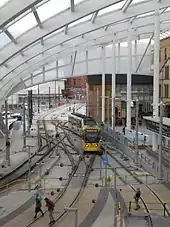
The tram platforms opened on 6 April 1992 for services to Bury which replaced the long-established heavy rail service. The tram platforms were built on the site of the former railway platforms 5 to 8, the terminus of the Bury line. The line was extended into the city-centre streets via a sharp curve south from the platform ends and out through a new entrance in the wall at the side of the station;[29][50] The system operates on some British Rail lines that have been converted to light rail operation and on-street tram tracks. In October 2009 the Oldham Loop Line was closed for conversion to a Metrolink line. It was completed in March 2014 after reopening in stages to Rochdale town centre.[51][52]
The 1992 Metrolink platforms consisted of an island platform containing platforms B and C, and a side platform for Bury bound trams lettered A, which was later taken out of use due to leaks in the station roof.[50]
The Metrolink platforms at Victoria closed on 21 February 2014 and were rebuilt in a different configuration to allow for increased services.[53] The rebuilt stop reopened on 18 February 2015. The new configuration has two island platforms serving three tracks, with platform faces lettered A, B, C and D; the outer platforms A and D are for through trams, south and northbound respectively, and the centre platforms B & C, which both serve the same track, accommodate terminating services.[54][55][56] The stop is one of the most used on the Metrolink network.[57]
Metrolink services
As of 2017, Metrolink services run through Victoria to Altrincham, Bury, East Didsbury, Manchester Airport, Oldham and Rochdale and Piccadilly. Services mostly run every six to twelve minutes on all routes.[58][59]
| Preceding station | Following station | |||
|---|---|---|---|---|
towards Manchester Airport | Manchester Airport – Victoria Line | Terminus | ||
towards Altrincham | Altrincham – Bury Line | towards Bury |
||
towards Piccadilly | Bury – Piccadilly Line | |||
towards East Didsbury | East Didsbury – Shaw and Crompton Line | towards Shaw and Crompton |
||
| East Didsbury – Rochdale Town Centre Line | towards Rochdale Town Centre |
Accidents and incidents

- On 19 August 1918, an electric train collided with the buffers, injuring 29 people.[60][61]
- On the early morning of 10 December 1947 a train of 20 tank wagons loaded with petrol ran out of control while descending the bank towards Victoria. To avoid a collision with another train, it was diverted into the empty bay platform 7, where it crashed through the buffers at 25 mph, mounted the concourse, and came to a rest just short of the booking office. Swift action was taken to prevent an outbreak of fire. The train driver was killed in the collision, the fireman was injured and the guard suffered from shock.[62][63]
- On 25 April 1994, two vehicles of a freight train derailed while passing through new platform six, which had opened that day. The derailed vehicles damaged the platform edging stones along most of its length, putting it out of use until it was repaired.[64]
- On 15 June 1996 a large truck bomb was detonated about 400 metres from the station by the Provisional IRA. The blast shattered many windows along the station's facade, and glass fell onto the glass canopy causing it serious damage. The station was closed for several days. The blast also damaged the glass and steel roof over the concourse and platforms, which resulted in the removal of much of the glasswork and cladding.[46][65]
- On 18 October 2016, a panel of the roof, which had been built the year before, collapsed under the weight of rain water, causing minor injury to two people.[66] The damage was blamed on seagulls weakening the structure by pecking at the roof.[67]
- On 22 May 2017, the station was evacuated and closed and services were cancelled following the bombing at Manchester Arena which is partially above the station.[68] The explosion took place in the public area linking the station to the Arena immediately above the station's through platforms,[69] causing structural damage to the station which was closed resulting in significant disruption to train and tram services.[70] The station reopened to traffic on 30 May 2017, following the police investigation and repairs to the fabric of the building.[71] A memorial space created following the bombing exists adjacent to the 'Soldier's Gate' Memorial.[72][73]
- On 31 December 2018, three people, including a police officer were stabbed at around 20:50 GMT. A man was held on suspicion of attempted murder.[74]
See also
References
- Footnotes
- Citations
- Historic England. "Victoria Station including concourse to rear with restaurant and booking hall (1254725)". National Heritage List for England. Retrieved 5 April 2013.
- "Is Victoria UK's worst station?". BBC News. 17 November 2009. Retrieved 19 January 2014.
- "Manchester Victoria station's restoration works start". BBC News. 9 April 2013. Retrieved 9 April 2013.
- "Manchester Victoria upgrades to be finished this month". www.railtechnologymagazine.com.
- "Engineering work at Manchester Victoria stops trains". BBC News. 15 November 2013.
- "Manchester Victoria Metrolink station closes for upgrade". BBC News. 2 May 2014. Retrieved 2 May 2014.
- "Manchester Victoria Station". Arcadis. Retrieved 21 February 2017.
- Wray 2004, pp. 1-5.
- Ferneyhough 1980, p. 105
- Goode, C.T. (1986). The Railways of Manchester. pp. 19, 30–31. ISBN 0-9508239-8-8.
- Marshall, J.D. (1970). The Lancashire and Yorkshire Railway, volume 1. David and Charles. p. 56. ISBN 0-7153-4352-1.
- Wells, Jeffrey (2000). The Eleven Towns Railway. Railway and Canal Historical Society. p. 74.
- "Victoria Station". manchesterhistory.net. Retrieved 13 May 2017.
- Wray 2004, p. 21.
- Wray 2004, pp. 30-33.
- Wray 2004, pp. 36-41.
- Wray 2004, pp. 59-62.
- Wray 2004, pp. 73-91.
- Wray 2004, pp. 64-72.
- "Parcel carrier, 1912". Science and Society. Retrieved 30 November 2018.
- Joyce, J. (1982), Roads and Rails of Manchester 1900-1950, Ian Allan Ltd, p-23 ISBN 0-7110-1174-5
- Marshall, John (1970), The Lancashire & Yorkshire Railway, volume 2, Newton Abbot: David & Charles, p=67 ISBN 0-7153-4906-6
- "A Brief Rail History of Manchester". Light Rail Transit Association. Retrieved 16 May 2017.
- "Manchester Exchange station". Disused Stations. Retrieved 14 August 2017.
- Wray 2004, pp. 124-125.
- SELNEC Picc-Vic Line, SELNEC PTE, October 1971 publicity brochure
- Wray 2004, p. 120.
- Coward, Andy. "Winning Station". PressReader.com. Rail Magazine. Retrieved 17 April 2017.
- Wray 2004, p. 128.
- "A Brief Rail History of Manchester: 1980s developments". Light Rail Transit Association. Retrieved 22 May 2017.
- Holt, Geoffery (1986). A Regional History of the Railways of Great Britain, Volume 10, The North West. David St John Thomas. p. 244. ISBN 0-946537-34-8.
- Wray 2004, pp. 126-129.
- Weaver, Matthew (17 November 2009). "Off the rails: Britain's 10 worst stations named and shamed". The Guardian. London. Retrieved 7 March 2012.
- "Manchester Victoria station's £30m revamp now uncertain". BBC News. 25 May 2010.
- "£50m revamp for 'worst stations'". BBC News. 17 November 2009. Retrieved 17 November 2009.
- "Victoria revamp to get go-ahead despite cash blow". Manchester Evening News. 4 August 2010.
- "North West electrification". Network Rail. n.d. Retrieved 21 February 2015.
- "Manchester Victoria station's restoration works start". BBC News. 9 April 2013. Retrieved 13 April 2013.
- "Manchester Victoria station redevelopment". Railway Technology. Retrieved 21 February 2017.
- "Manchester Victoria reopens after £44m upgrade". BBC News. 6 October 2015. Retrieved 6 October 2015.
- "Manchester Victoria – Timeline". Network Rail. Archived from the original on 7 June 2012.
- "Report for Resolution – Manchester Victoria Station" (PDF). Manchester City Council. 20 December 2012. Retrieved 15 March 2013.
- Wray 2004, pp. 103-105.
- "Better rail services become a reality between Liverpool Lime Street and Manchester Airport station". Network Rail Media Centre. Network Rail. 5 March 2015. Archived from the original on 9 March 2015. Retrieved 5 March 2015.
- "First electric passenger trains finally entering service in Bolton". The Bolton News. 12 February 2019. Retrieved 7 August 2019.
- Wray 2004, p. 130.
- "A bright new Victoria station". Rail Engineer. Retrieved 20 May 2017.
- Wray 2004, p. 111.
- "Manchester Victoria station officially reopens after £44m overhaul". Manchester Evening News. Retrieved 20 May 2017.
- "Victoria Metrolink stop". TheTrams. Retrieved 7 December 2016.
- "A Brief Rail History of Manchester". LRTA. Retrieved 7 December 2016.
- "Metrolink History 1". LRTA. Retrieved 7 December 2016.
- "Metrolink: Time to make Victoria posh" (Press release). Transport for Greater Manchester. 6 February 2014. Archived from the original on 22 February 2014. Retrieved 7 February 2014.
- "Manchester Victoria Metrolink stop reopens in £44m upgrade". BBC News. 18 February 2015. Retrieved 21 February 2015.
- "Metrolink in the City Centre". Light Rail Transit Association. Retrieved 13 May 2017.
- "Manchester Victoria Station Metrolink Platforms". Geograph.org. Retrieved 21 May 2017.
- "Transport Statistics Greater Manchester 2017 Public Transport Section". TfGM. 5 December 2019. Retrieved 14 December 2019.
- "Metrolink tram times". Transport for Greater Manchester. Retrieved 29 January 2018.
- "Metrolink route map (pdf)". TfGM. Retrieved 29 January 2018.
- Wray 2004, p. 105.
- "Accident at Manchester Victoria on 19th August 1918". railwaysarchive.co.uk. Retrieved 24 May 2017.
- Wray 2004, p. 121.
- "Ministry of Transport report into the accident" (PDF). railwaysarchive.co.uk. Retrieved 24 May 2017.
- Wray 2004, p. 129.
- "Victoria: the rebirth of a railway station". Rail Magazine. Retrieved 7 June 2017.
- "Injuries after Manchester Victoria Station roof collapse". BBC News. 18 October 2016.
- "Hungry seagulls blamed for Manchester Victoria station roof collapse". ITV news. Retrieved 3 June 2017.
- "Deaths, injuries after reports of explosion at Ariana Grande concert at Manchester Arena: Police". ABC News. 22 May 2017. Retrieved 22 May 2017.
- Chivers, C.L. (24 May 2017). "Found at the Scene in Manchester: Shrapnel, a Backpack and a Battery". The New York Times. Retrieved 24 May 2017.
- "Structural damage to Victoria Station after bomb". ITV News. Retrieved 26 May 2017.
- "Manchester attack: Victoria railway station reopens". BBC News. Retrieved 30 May 2017.
- "Manchester Arena bombing: K-Pop band Blackpink pay on-stage tribute". BBC News. 22 May 2019. Retrieved 22 December 2019.
- Twitter. 14 September 2019 https://twitter.com/birdsnestsblog/status/1172848959724904449. Retrieved 22 December 2019.
The story of Manchester Victoria station was changed massively in May 2017 with the Manchester Arena bombing. The memorial stands, not just on the anniversary, but all year around. Perfectly kept and a fitting tribute to the twenty-two killed.
Missing or empty|title=(help) - "Manchester Victoria station stabbing: Three injured". BBC News. 1 January 2019. Retrieved 1 January 2019.
Bibliography
- Wray, Tom (2004). Manchester Victoria Station. Peter Taylor Publications. ISBN 0-9549451-0-7.
- Axon, William E. (1886). "The annals of Manchester: a chronological record from the earliest times to the end of 1885". Manchester and London: J. Heywood, Deansgate and Ridgefield. Retrieved 21 October 2013. Cite journal requires
|journal=(help) - Bairstow, Martin (1987). The Manchester & Leeds Railway : the Calder Valley Line. M. Bairstow. ISBN 0-9510302-6-4.
- Ferneyhough, Frank (1980). Liverpool & Manchester Railway 1830–1980. Book Club Associates.
Further reading
External links
| Wikimedia Commons has media related to Manchester Victoria station. |
- Train times and station information for Manchester Victoria station from National Rail
- Tram times and station information for Manchester Victoria station from Manchester Metrolink
- Victoria area map
Manchester railways | ||||||||||||||||||||||||||||||||||||||||||||||||||||||||||||||||||||||||||||||||||||||||||||||||||||||||||||||||||||||||||||||||||||||||||||||||||||||||||||||||||||||||||||||||||||||||||||||||||||||||||||||||||||||||||||||||||||||||||||||||||||||||||||||||||||||||||||||||||||
|---|---|---|---|---|---|---|---|---|---|---|---|---|---|---|---|---|---|---|---|---|---|---|---|---|---|---|---|---|---|---|---|---|---|---|---|---|---|---|---|---|---|---|---|---|---|---|---|---|---|---|---|---|---|---|---|---|---|---|---|---|---|---|---|---|---|---|---|---|---|---|---|---|---|---|---|---|---|---|---|---|---|---|---|---|---|---|---|---|---|---|---|---|---|---|---|---|---|---|---|---|---|---|---|---|---|---|---|---|---|---|---|---|---|---|---|---|---|---|---|---|---|---|---|---|---|---|---|---|---|---|---|---|---|---|---|---|---|---|---|---|---|---|---|---|---|---|---|---|---|---|---|---|---|---|---|---|---|---|---|---|---|---|---|---|---|---|---|---|---|---|---|---|---|---|---|---|---|---|---|---|---|---|---|---|---|---|---|---|---|---|---|---|---|---|---|---|---|---|---|---|---|---|---|---|---|---|---|---|---|---|---|---|---|---|---|---|---|---|---|---|---|---|---|---|---|---|---|---|---|---|---|---|---|---|---|---|---|---|---|---|---|---|---|---|---|---|---|---|---|---|---|---|---|---|---|---|---|---|---|---|---|---|---|---|---|---|---|---|---|---|---|---|---|---|---|---|
City Centre and North Past, present and future | ||||||||||||||||||||||||||||||||||||||||||||||||||||||||||||||||||||||||||||||||||||||||||||||||||||||||||||||||||||||||||||||||||||||||||||||||||||||||||||||||||||||||||||||||||||||||||||||||||||||||||||||||||||||||||||||||||||||||||||||||||||||||||||||||||||||||||||||||||||
| ||||||||||||||||||||||||||||||||||||||||||||||||||||||||||||||||||||||||||||||||||||||||||||||||||||||||||||||||||||||||||||||||||||||||||||||||||||||||||||||||||||||||||||||||||||||||||||||||||||||||||||||||||||||||||||||||||||||||||||||||||||||||||||||||||||||||||||||||||||






